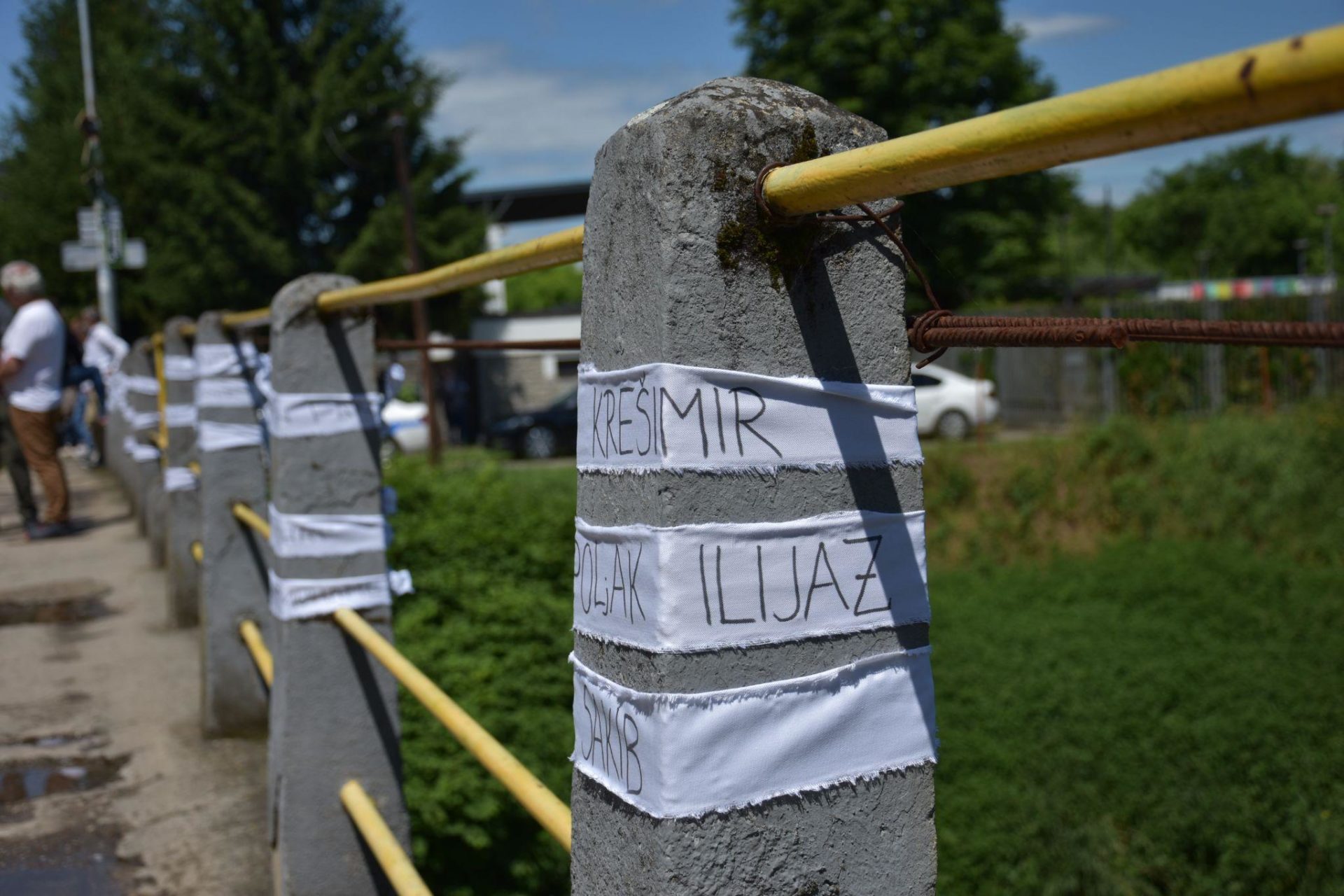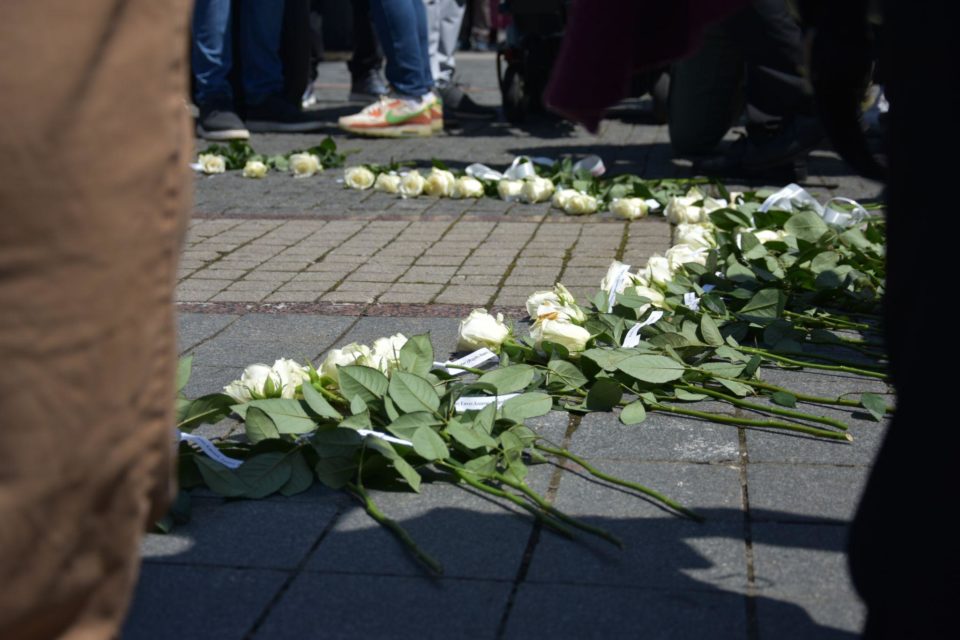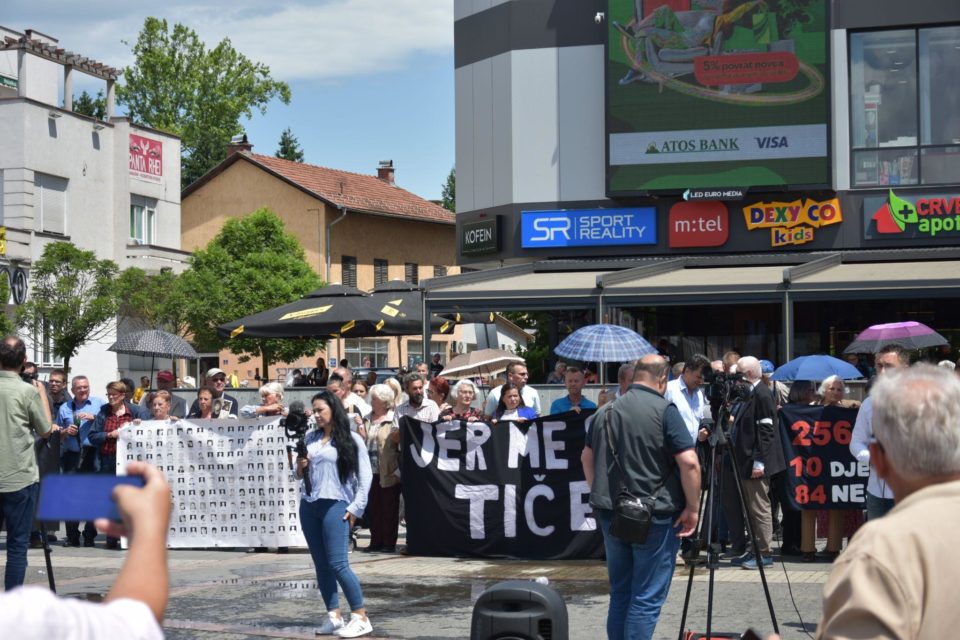
On May 23, 2012, Emir Hodžić went viral for standing alone in Prijedor’s main square, wearing a white armband on his left arm. The white armband, now used as a symbol of remembrance, commemorated the decree issued by Serb nationalist authorities in Prijedor (Crisis Committee of the Serbian District of Prijedor) on May 31, 1992, ordering the non-Serb population of Prijedor to hang white sheets outside their homes and to wear a white armband.
This decree was followed by a campaign of “ethnic cleansing” and mass atrocities against the non-Serb civilians of the Prijedor municipality, as part of the war in Bosnia which unfolded in 1992-1995. Today, Prijedor is located in the Republika Srpska (RS), the majority-Serb entity of Bosnia and Herzegovina. Between 1992 and 1995, 3,176 civilians, including 102 children, were killed in Prijedor.
May 23, 2012, marked the twentieth anniversary of when the attacks against non-Serb civilians in Prijedor began. In front of him in the square, Hodžić laid out white fabric made to look like a body bag. Initially, local associations of returnees, camp survivors, and families of the missing had created a commemoration committee and organized a commemoration program titled, “Genocide in Prijedor – 20 years”. It had been planned that during the commemoration, participants would place 266 body bags and roses on Prijedor’s main square, symbolizing the 266 murdered women and girls of Prijedor — many of whom were tortured and raped in camps prior to their deaths — to draw attention to the sexual violence during the war.
This would have been the first commemoration of non-Serb victims in Prijedor. It was, however, banned by public security authorities, who claimed that it could “incite violence and disturb public order”. The then Prijedor mayor, Marko Pavić, also said that any marking of the 20th anniversary of the genocide in Prijedor would “harm the city’s reputation”.
Hodžić stood in the square nonetheless. It was his first time back in Prijedor — his hometown — since his expulsion. In an interview with the New Yorker, he described experiencing the same feeling of “dehumanization” and othering that he had felt in 1992. Prior to his act of peaceful resistance, he had created a Facebook page called “Stop Genocide Denial” with a few friends. Afterward, Hodžić posted a photo that someone had taken of him, standing alone in the square with a white armband, to increase awareness about the situation. Quickly, the photo went viral.
The following year on May 31, 2013, social media users from around the world posted photos wearing white armbands and writing messages in support of the struggle of non-Serb victims against injustice. Thus, a global social media campaign called “White Armband Day,” or “Dan Bijelih Traka” was born. Jer me se tiče (Because It Concerns Me), a youth-led initiative that “advocates the establishment of complete and non-selective respect for the human rights and freedoms of all citizens,” also organized the first annual protest walk in Prijedor, where local government authorities make it difficult to achieve progress in realizing parents’ goal of creating a permanent memorial. Activists from local associations and other parts of the country gathered for the first time to march for their right to remember.
According to Joanna Paul, a Research Assistant in the Sociology of Transnationalization, Migration and Development at Bielefeld University, White Armband Day is “one of the most successful civil society initiatives engaging in dealing with the past in the region,”. It has led to widespread recognition and support both in the region and across the world in virtual spaces. To understand the legacy of the movement, one has to explore the movement’s symbolism, how the memory of White Armband Day has had to relocate in space and time to perpetuate itself, and the effectiveness of these methods in ensuring that Bosnia and Herzegovina’s youth remembers the atrocities that occurred in the war.
Symbolism Against Revisionism
White Armband Day brings people together behind a powerful symbol, demonstrating the symbolic resistance of memory against revisionism. Indeed, White Armband Day exemplifies the powerful reversal of stigma, turning a symbol of discrimination into a symbol of remembrance and resilience. Forcing the non-Serb population to wear a white armband aimed to strip them of their humanity, reduce them to labeled objects, and thus, targets of “ethnic cleansing”. This forced symbolization of an ethnic group, which constitutes the second stage of genocide as per Gregory Stanton’s classification, is reminiscent of the obligation for Jewish people to wear a white armband with a blue Star of David under Nazi rule, or the compulsory wearing of a blue scarf for people from the Eastern Zone in Khmer Rouge Cambodia. Today, the symbol of the white armband has been reappropriated by survivors and activists in Prijedor as a means of reclaiming their humanity and dignity.

This process of stigma reversal serves to subvert the original signification of the white armband. Indeed, the white armband has evolved from a sign of dehumanization and exclusion to a symbol that gives their humanity back to survivors and empowers them. By wearing a white armband on May 31, people not only commemorate the victims in Prijedor but also demonstrate their enduring presence, defying the people who tried to erase them during the “ethnic cleansing” campaign and who, today, seek to conceal any trace of the crimes.
Monument as a Warning and Guarantee
Since 2014, the parents of the 102 murdered children of Prijedor have been demanding the construction of a permanent, physical monument in the Prijedor city center to commemorate their children, which the local RS authorities have refused. This demand has also been one of the main focuses of the activist group, Jer me se tiče. Fikret Bačić, the parent of a twelve-year-old son and six-year-old daughter who were killed in 1992, spoke in Prijedor city center on May 31, 2024, on behalf of the Initiative of Parents of Murdered Children. He said, “The monument that we want to erect to our children killed in 1992 and 1993 should be a warning and a guarantee that not a single child will ever be killed again in our city.”
Yet, local RS authorities continue to ignore these requests. Bačić told us that during their ten-year struggle, four mayors and four presidents of the City Assembly had come and gone, “and none of them had enough humanity to take a historic step forward and approve the construction of the first monument to the civilian victims of the war in Prijedor.”
Recently, Slobodan Javor was elected mayor of Prijedor, and since then the process “has been completely blocked.” His refusal to meet with the activist groups or negotiate the monument represents Prijedor’s — and the RS’s — continued denial that crimes against humanity and other war crimes ever occurred in the region. Activist Melani Isović, who spoke to the square on May 31, 2024, on behalf of Jer me se tiče, referred to the victims in Prijedor as “invisible.” She said, “This is the essence of White Ribbon Day, to remember the victims that the authorities in that local community do not want to remember.”
In place of a permanent, physical monument, White Armband Day and the annual march on May 31 serve as a momentary reminder of what occurred in Prijedor. Further, there have been a series of temporary art installations that commemorate the children killed. The “Stop Genocide Denial” Facebook page originally launched by Emir Hodžić has documented the various art installations from 2014, 2015, and 2016. On August 26, 2014, there were red footprints throughout the square, and on August 30, 2014, white life-sized body cutouts, both for the International Day of Missing Persons. The following year on May 31, 2015, the art installation took the form of a stack of Lego-like cubes with the names of the 102 killed children on each of them. On May 31, 2016, it was a pile of children’s shoes, representing the 102 children of Prijedor who were killed. Since then, every year, parents of the murdered children place a symbolic white rose — with the name of their child on a slip of paper — into a ring in the city center. These temporary pieces of art serve as an alternative form of commemoration in place of the permanent, physical monument that the Prijedor parents and activist groups still advocate for in vain.
Virtual Campaign
White Armband Day has also had to morph into different spaces to sustain itself, despite the opposition of the RS authorities. The online space quickly became its new home. Indeed, White Armband Day has gained significant visibility through the campaign that has developed on social media since 2013. The campaign received international attention on social media due to the mobilization of the diaspora and the relaying of posts in English, in addition to posts in BCMS (Bosnian-Croatian-Montenegrin-Serbian). Such a bilingual approach has facilitated broader engagement and awareness from the international community. On Instagram, for example, almost a third of the posts with a hashtag linked to white armband day were in English (581 posts for #whitearmbandday compared with 1,210 posts with the hashtag #danbijelihtraka).
This shift of commemoration into a virtual space was necessitated by a politically adverse environment that resisted acknowledging the atrocities committed in Prijedor. The refusal of the local authorities in Prijedor to introduce memorials and to authorize commemorations created a need for victims and activists to have an alternative, counter-hegemonic discursive space. However, some people, like young photographer Nidal Šaljić, deplore the fact that this movement on social media is a once-a-year occurrence, with posts only being relayed on May 31st.
In the same way, physical commemorations have also been relocated to and duplicated in different physical sites. Indeed, White Armband Day is celebrated abroad to avoid Serb opposition in the Prijedor region. This has been made possible thanks to the diaspora who organize their gatherings on May 31st, wearing white armbands in cities such as Stockholm, Rotterdam, Chicago, Zagreb, or Saarbrücken. This has helped to raise awareness around the world about the campaign of “ethnic cleansing” that took place in the municipality of Prijedor.
“The White Armband Commission”, established three years ago in Switzerland, shares the same goal. According to Ajla Kuduzović, President of the White Armband Commission in Switzerland, the resistance they faced on the ground in BiH was not only coming from the authorities but also from the local Serb population, thus making it easier for them to work from Switzerland.
Youth Perspective and Fighting Revisionism in Prijedor
Young people are essential to the perpetuation of the memory of the atrocities committed in Prijedor. The question of their involvement in the White Armband Day initiative is, therefore, crucial. Nevertheless, the Bosnian youth seem to be far removed from such remembrance initiatives according to Nidal Šaljić. “Now, a lot of young people are not interested [in learning about] the war,” he said. “They think, ‘That happened 30 years [ago], we have the Defense of Sarajevo’, and that’s it.” This attitude can be explained by the lack of educational resources on the war and the events that took place in Prijedor, which often leaves parents as the main source of information for the new generation.
This lack of awareness appears to be present at an international level. Even though the social media campaign reached an international audience, Kuduzović said “I don’t think there is any awareness in that regard”.
Organizations that promote White Armband Day — such as Jer me se tiče and The White Armband Commission — are an important part of the resistance against the hatred and denial that continues to emerge from the RS political establishment. On the day before White Armband Day this year — May 30 — a parade was organized through the same street on the so-called “City Defense Day” or “Defense Day Against Muslims and Croats.” During the parade, Serbian victims were mentioned, flowers were laid, and some Serbs were mentioned, but there was no mention of the non-Serb civilians killed in Prijedor on May 30, 1992.

Developing a Sustainable Culture of Peace
Various initiatives have emerged to support and acknowledge the crimes committed in and around Prijedor during the war. This year, the first PCRC International Youth School took place from May 29 to 31, and it included a panel of survivors who spoke about their experiences in the camps and after the war.
Despite a political context that is hostile to the recognition and commemoration of the suffering of non-Serb populations, the organizers of White Armband Day stress its importance in bridging the divides between various interpretations of history. “Today’s politicians, national and religious champions, are just as dedicated to dividing people as those who did it during the war,” Isović said. “By celebrating the Day of White Ribbons, we want to show that it is possible to do otherwise. That together we can remember all innocent victims and accept that all victims of war are our common victims, regardless of their identity.”.
We have seen that, today, the memory of the atrocities committed at Prijedor is sustained by White Armband Day, both in the municipality and abroad, which means that the memory of the victims lives on. In the future, it seems that the memorialization of the “ethnic cleansing” campaign led in Prijedor will need to extend beyond ethnic barriers, to cultivate a lasting culture of peace.
—————
This text was created with the support of the “SMART Balkans – Civil Society for Shared Society in the Western Balkans” regional project implemented by the Center for the Promotion of Civil Society (CPCD), Center for Research and Policy Making (CRPM) and Institute for Democracy and Mediation (IDM) and financially supported by the Norwegian Ministry of Foreign Affairs (NMFA). The content of the publication is the sole responsibility of the project implementers and does not necessarily reflect the views of the Norwegian Ministry of Foreign Affairs (NMFA) or SMART Balkans consortium partners.







